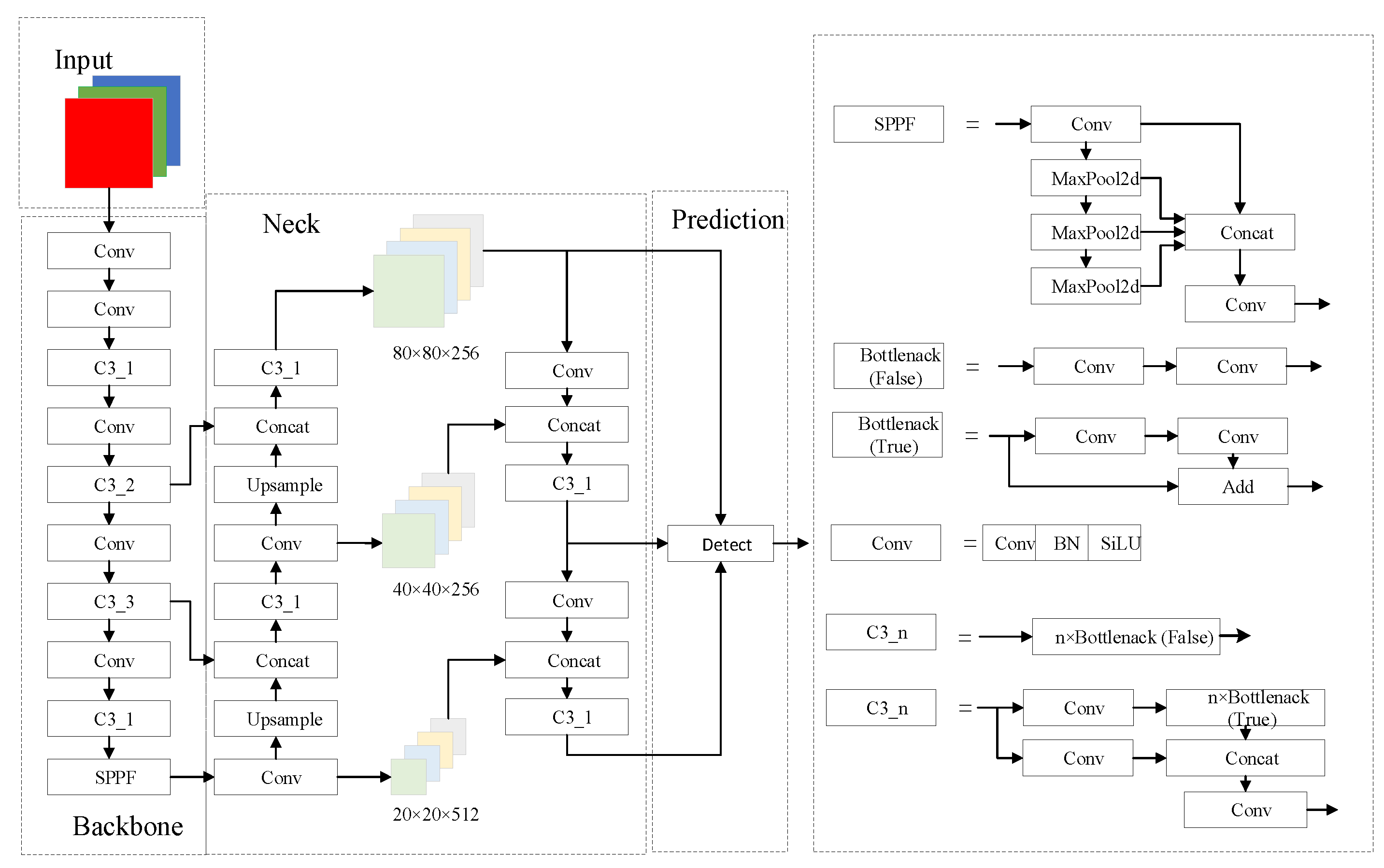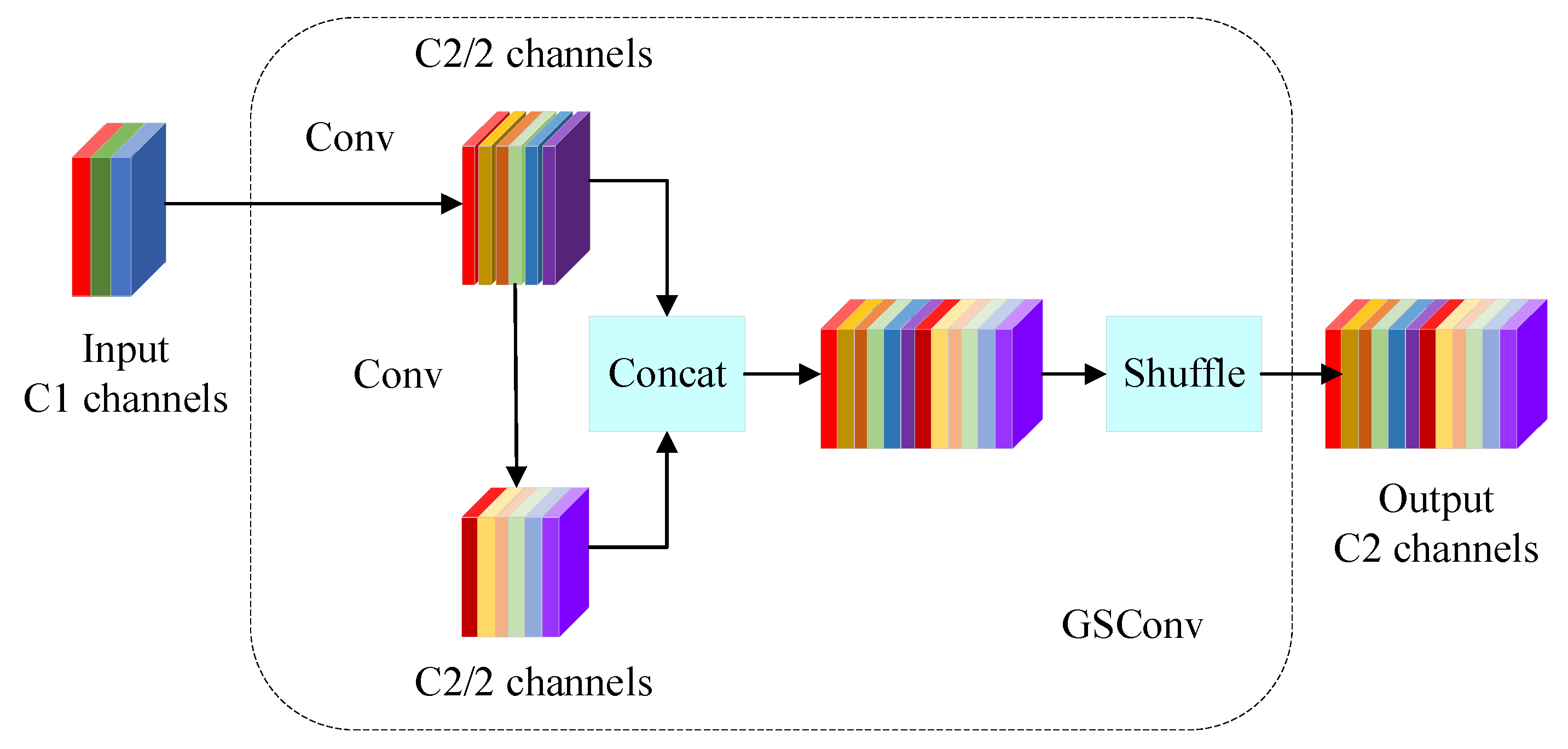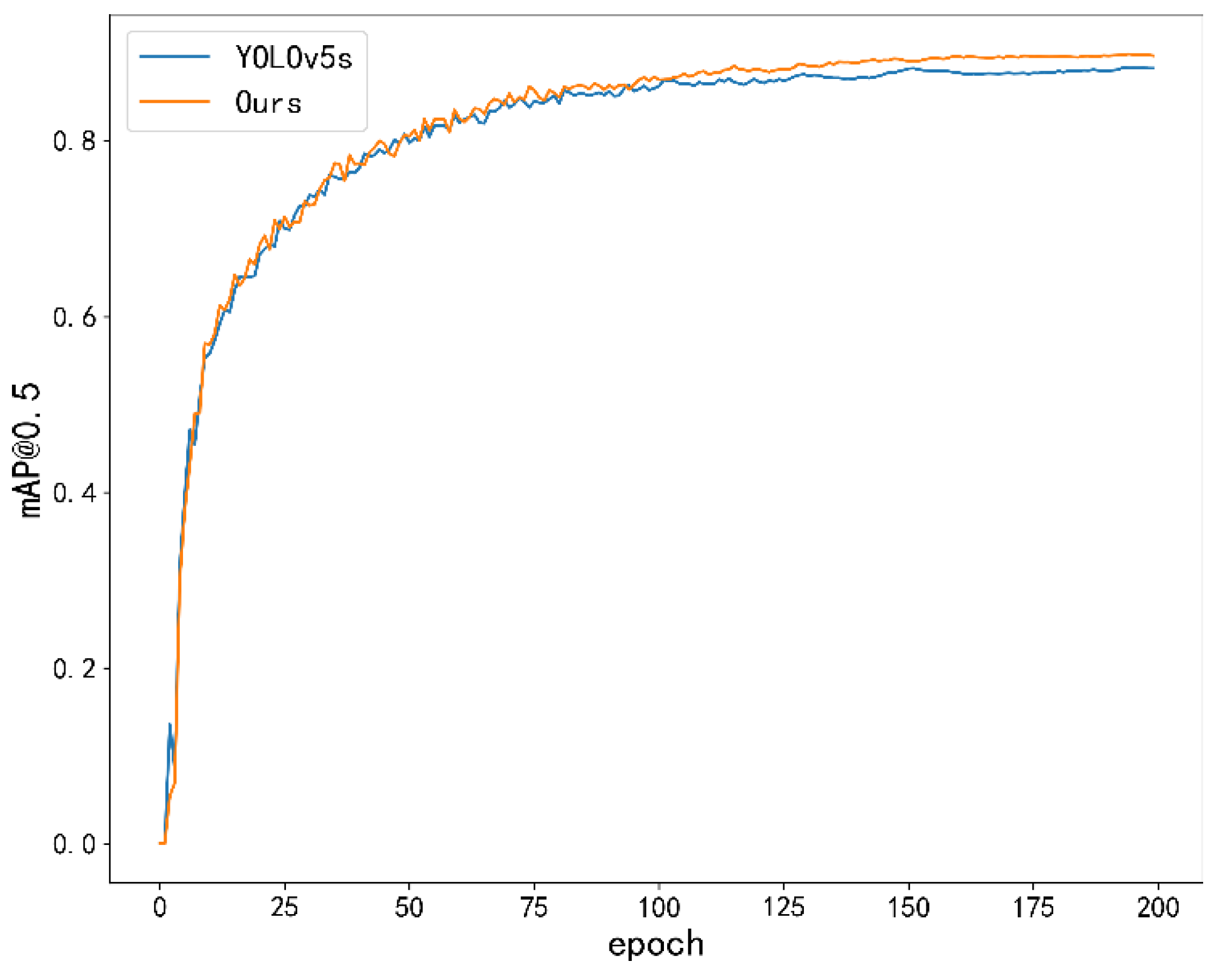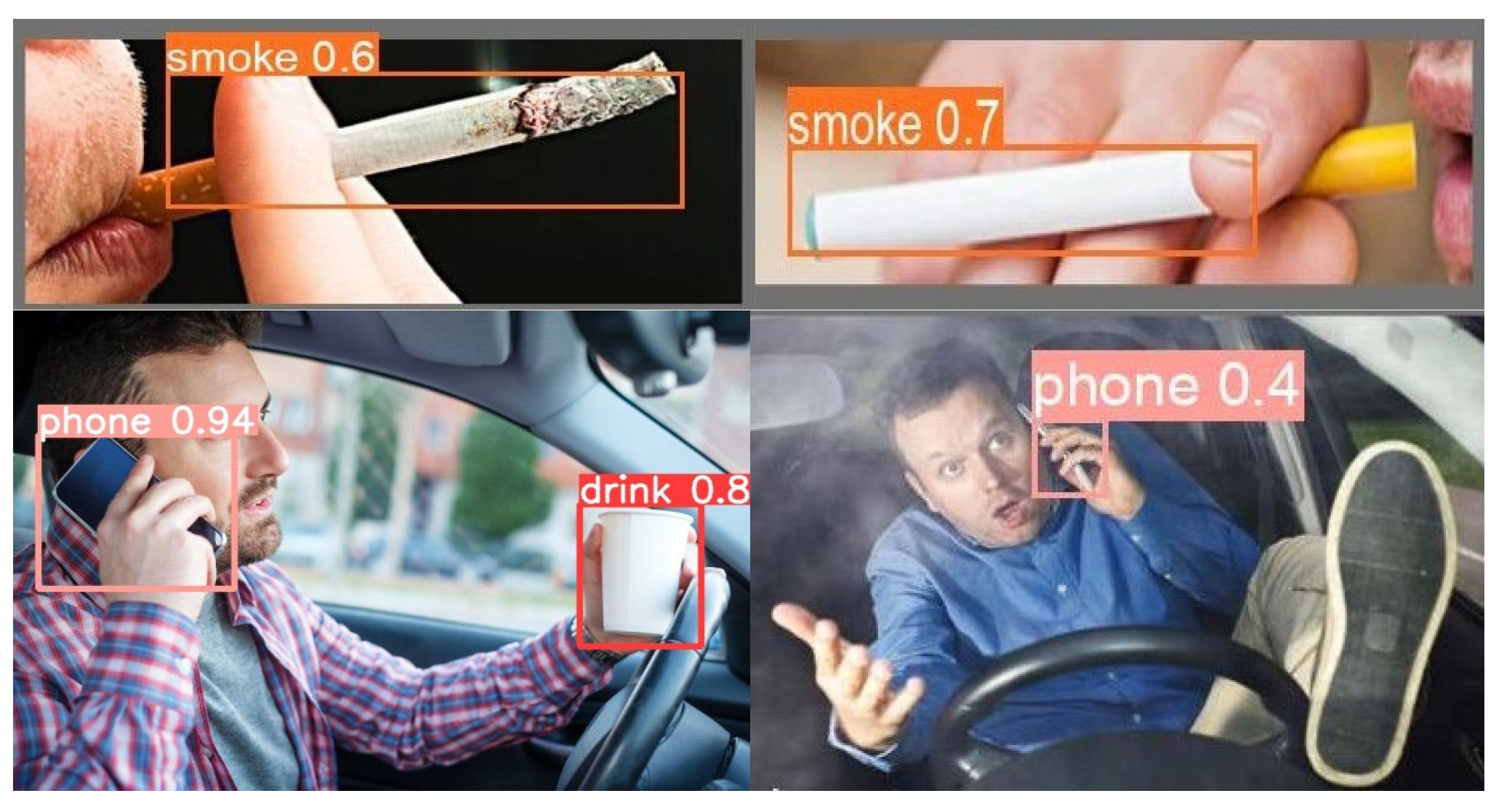Research on Lightweight-Based Algorithm for Detecting Distracted Driving Behaviour
Abstract
:1. Introduction
2. YOLOv5 Target Detection Algorithm
3. The Algorithm in This Paper
3.1. Overall Network Structure
3.2. Lightweight Model Ghostnet
3.3. Lightweight Convolution Method GSConv
3.4. CBAM
3.5. The Soft-NMS Algorithm
| Algorithm 1: Flow of Soft-NMS algorithm. |
| Inputs: Initial Anchor Frame Set B, Score set S, Overlap Ratio Threshold |
| Output: Updated Anchor Box Set and Score Set |
| while do |
| for |
| end |
| end |
4. Experimental Results and Analysis
4.1. Dataset Production
4.2. Configuration of Parameters and Evaluation of Indicators
4.3. Experimental Results and Analysis
5. Conclusions
Author Contributions
Funding
Institutional Review Board Statement
Informed Consent Statement
Data Availability Statement
Conflicts of Interest
References
- He, K.; Gkioxari, G.; Dollár, P.; Girshick, R. Mask R-CNN. In Proceedings of the IEEE International Conference on Computer Vision, Venice, Italy, 22–29 October 2017; pp. 2961–2969. [Google Scholar]
- Ren, S.; He, K.; Girshick, R.; Sun, J. Faster R-CNN: Towards realtime object detection with region proposal networks. In Proceedings of the 2015 Advances in Neural Information Processing Systems, Montreal, QC, Canada, 7–12 December 2015; pp. 91–99. [Google Scholar]
- Girshick, R. Fast RCNN. In Proceedings of the 2015 IEEE International Conference on Computer Vision, Santiago, Chile, 7–13 December 2015; pp. 1440–1448. [Google Scholar]
- Girshick, R.; Donahue, J.; Darrell, T.; Malik, J. Rich feature hierarchies for accurate object detection and semantic segmentation. In Proceedings of the 2014 IEEE Conference on Computer Vision and Pattern Recognition, Columbus, OH, USA, 23–28 June 2014; pp. 580–587. [Google Scholar]
- Liu, W.; Anguelov, D.; Erhan, D.; Szegedy, C.; Reed, S.; Fu, C.Y.; Berg, A.C. SSD: Single shot multibox detector. In Proceedings of the 2016 European Conference on Computer Vision, Amsterdam, The Netherlands, 11–14 October 2016; pp. 21–37. [Google Scholar]
- Jeong, J.; Park, H.; Kwak, N. Enhancement of SSDby concatenating feature maps for object detection. arXiv 2017, arXiv:1705.09587. [Google Scholar]
- Fu, C.Y.; Liu, W.; Ranga, A.; Tyagi, A.; Berg, A.C. DSSD: Deconvolutional single shot detector. arXiv 2017, arXiv:1701.06659. [Google Scholar]
- Li, Z.; Zhou, F. FSSD: Feature fusion single shot multibox detector. arXiv 2017, arXiv:1712.00960. [Google Scholar]
- Redmon, J.; Divvala, S.; Girshick, R.; Farhadi, A. You only look once: Unified, realtime object detection. In Proceedings of the IEEE Conference on Computer Vision and Pattern Recognition, Las Vegas, NV, USA, 27–30 June 2016; pp. 779–788. [Google Scholar]
- Redmon, J.; Farhadi, A. Yolo9000: Better, faster, stronger. In Proceedings of the IEEE Conference on Computer Vision and Pattern Recognition, Honolulu, HI, USA, 21–26 July 2017; pp. 7263–7271. [Google Scholar]
- Redmon, J.; Farhadi, A. YOLOv3: Anincremental improvement. arXiv 2018, arXiv:1804.02767. [Google Scholar]
- Bochkovskiy, A.; Wang, C.Y.; Liao, H.Y.M. YOLOv4: Optimal speed and accuracy of object detection. arXiv 2020, arXiv:2004.10934. [Google Scholar]
- Vosugh, N.; Bahmani, Z.; Mohammadian, A. Distracted driving recognition based on functional connectivity analysis between physiological signals and perinasal perspiration index. Expert Syst. Appl. 2023, 231, 120707. [Google Scholar] [CrossRef]
- Luo, G.; Xiao, W.; Chen, X.; Tao, J.; Zhang, C. Distracted driving behaviour recognition based on transfer learning and model fusion. Int. J. Wirel. Mob. Comput. 2023, 24, 159–168. [Google Scholar] [CrossRef]
- Ping, P.; Huang, C.; Ding, W.; Liu, Y.; Chiyomi, M.; Kazuya, T. Distracted driving detection based on the fusion of deep learning and causal reasoning. Inf. Fusion 2023, 89, 121–142. [Google Scholar] [CrossRef]
- Lin, Y.; Cao, D.; Fu, Z.; Huang, Y.; Song, Y. A Lightweight Attention-Based Network towards Distracted Driving Behavior Recognition. Appl. Sci. 2022, 12, 4191. [Google Scholar] [CrossRef]
- Zhao, X.; Li, C.; Fu, R.; Ge, Z.; Wang, C. Real-time detection of distracted driving behaviour based on deep convolution-Tokens dimensionality reduction optimized visual transformer. Automot. Eng. 2023, 45, 974–988+1009. [Google Scholar] [CrossRef]
- Cao, L.; Yang, S.; Ai, C.; Yan, J.; Li, X. Deep learning based distracted driving behaviour detection method. Automot. Technol. 2023, 06, 49–54. [Google Scholar] [CrossRef]
- Zhang, B.; Fu, J.; Xia, J. A training method for distracted driving behaviour recognition model based on class spacing optimization. Automot. Eng. 2022, 44, 225–232. [Google Scholar] [CrossRef]
- Feng, T.; Wei, L.; Wenjuan, E.; Zhao, P.; Li, Z.; Ji, Y. A distracted driving discrimination method based on the facial feature triangle and bayesian network. Balt. J. Road Bridge Eng. 2023, 18, 50–77. [Google Scholar] [CrossRef]
- Chen, D.; Wang, Z.; Wang, J.; Shi, L.; Zhang, M.; Zhou, Y. Detection of distracted driving via edge artificial intelligence. Comput. Electr. Eng. 2023, 111, 108951. [Google Scholar] [CrossRef]
- Lu, M.; Hu, Y.; Lu, X. Pose-guided model for driving behavior recognition using keypoint action learning. Signal Process. Image Commun. 2022, 100, 116513. [Google Scholar] [CrossRef]
- Dehzangi, O.; Sahu, V.; Rajendra, V.; Taherisadr, M. GSR-based distracted driving identification using discrete & continuous decomposition and wavelet packet transform. Smart Health 2019, 14, 100085. [Google Scholar]
- Omerustaoglu, F.; Sakar, C.O.; Kar, G. Distracted driver detection by combining in-vehicle and image data using deep learning. Appl. Soft Comput. 2020, 96, 106657. [Google Scholar] [CrossRef]
- Zhao, L.; Yang, F.; Bu, L.; Han, S.; Zhang, G.; Luo, Y. Driver behavior detection via adaptive spatial attention mechanism. Adv. Eng. Inform. 2021, 48, 101280. [Google Scholar] [CrossRef]
- Hossain, M.U.; Rahman, M.A.; Islam, M.M.; Akhter, A.; Uddin, M.A.; Paul, B.K. Automatic driver distraction detection using deep convolutional neural networks. Intell. Syst. Appl. 2022, 14, 200075. [Google Scholar] [CrossRef]
- Zhang, Y.; Chen, Y.; Gao, C. Deep unsupervised multi-modal fusion network for detecting driver distraction. Neurocomputing 2021, 421, 26–38. [Google Scholar] [CrossRef]
- Singh, H.; Sidhu, J. Smart Detection System for Driver Distraction: Enhanced Support Vector Machine classifier using Analytical Hierarchy Process technique. Procedia Comput. Sci. 2023, 218, 1650–1659. [Google Scholar] [CrossRef]
- Aljohani, A.A. Real-time driver distraction recognition: A hybrid genetic deep network based approach. Alex. Eng. J. 2023, 66, 377–389. [Google Scholar] [CrossRef]
- Xiao, W.; Liu, H.; Ma, Z.; Chen, W. Attention-based deep neural network for driver behavior recognition. Future Gener. Comput. Syst. 2022, 132, 152–161. [Google Scholar] [CrossRef]
- Lu, M.; Hu, Y.; Lu, X. Dilated Light-Head R-CNN using tri-center loss for driving behavior recognition. Image Vis. Comput. 2019, 90, 103800. [Google Scholar] [CrossRef]
- Cammarata, A.; Sinatra, R.; Maddio, P.D. Interface reduction in flexible multibody systems using the Floating Frame of Reference Formulation. J. Sound Vib. 2022, 523, 116720. [Google Scholar] [CrossRef]











| Layers | From | Parameters | Module |
|---|---|---|---|
| 0 | −1 | 224 | GSConv |
| 1 | −1 | 476 | Gbneck |
| 2 | −1 | 2668 | Gbneck |
| 3 | −1 | 3120 | Gbneck |
| 4 | −1 | 7482 | Gbneck |
| 5 | −1 | 12,318 | Gbneck |
| 6 | −1 | 15,684 | Gbneck |
| 7 | −1 | 10,608 | Gbneck |
| 8 | −1 | 149,404 | Gbneck |
| 9 | −1 | 150,452 | Gbneck |
| 10 | −1 | 295,880 | Gbneck |
| 11 | −1 | 91,880 | Gbneck |
| 12 | −1 | 553,880 | Gbneck |
| 13 | −1 | 91,880 | Gbneck |
| 14 | −1 | 553,880 | Gbneck |
| 15 | −1 | 854,978 | C3CBAM |
| 16 | −1 | 122,160 | GSConv |
| 17 | −1 | 65,152 | GSConv |
| 18 | −1 | 0 | Upsample |
| 19 | [−1,9] | 0 | Concat |
| 20 | −1 | 310,784 | C3 |
| 21 | −1 | 18,240 | GSConv |
| 22 | −1 | 0 | Upsample |
| 23 | [−1,5] | 0 | Concat |
| 24 | −1 | 77,568 | C3 |
| 25 | −1 | 75,584 | GSConv |
| 26 | [−1,21] | 0 | Concat |
| 27 | −1 | 296,448 | C3 |
| 28 | −1 | 298,624 | GSConv |
| 29 | [−1,16] | 0 | Concat |
| 30 | −1 | 1,297,408 | C3 |
| 31 | [24,27,30] | 21,576 | Detect |
| Model | CBAM | Ghostnet | GSConv | Soft-NMS | P (%) | R (%) | mAP@0.5 (%) |
|---|---|---|---|---|---|---|---|
| YOLOv5s | × | × | × | × | 88. 8 | 83.7 | 88.3 |
| Module A | √ | × | × | × | 90.8 | 85.6 | 89.1 |
| Module B | × | √ | × | × | 91.6 | 83.3 | 87.3 |
| Module C | × | × | √ | × | 90.6 | 86.5 | 89.7 |
| Module D | × | × | × | √ | 92.1 | 84.1 | 89.7 |
| This paper | √ | √ | √ | √ | 91.4 | 83.8 | 89.8 |
| Model | CBAM | Ghostnet | GSConv | Soft-NMS | Params () | GFLOPs | Inference (ms) |
|---|---|---|---|---|---|---|---|
| YOLOv5s | × | × | × | × | 7.0 | 15.8 | 11.3 |
| Module A | √ | × | × | × | 7.0 | 15.8 | 9.9 |
| Module B | × | √ | × | × | 4.9 | 7.8 | 10.7 |
| Module C | × | × | √ | × | 6.6 | 15.2 | 9.0 |
| Module D | × | × | × | √ | 7.0 | 15.8 | 7.3 |
| This paper | √ | √ | √ | √ | 5.4 | 8.2 | 11.2 |
| Model | P (%) | R (%) | mAP@0.5 (%) | ModelSize (M) | Params (106) | GFLOPs | Inference (ms) |
|---|---|---|---|---|---|---|---|
| YOLOv5s | 88.8 | 83.7 | 88.3 | 14.2 | 7.0 | 15.8 | 11.3 |
| SSD | 87.4 | 72.7 | 80.2 | 96.7 | 24.2 | 274.2 | 85.0 |
| YOLOv5x | 90.5 | 86.0 | 89.2 | 165.0 | 86.2 | 203.6 | 29.9 |
| YOLOv7 | 90.1 | 87.4 | 89.1 | 72.1 | 37.2 | 105.0 | 24.8 |
| This paper | 91.4 | 83.8 | 89.8 | 19.8 | 5.4 | 8.2 | 11.2 |
Disclaimer/Publisher’s Note: The statements, opinions and data contained in all publications are solely those of the individual author(s) and contributor(s) and not of MDPI and/or the editor(s). MDPI and/or the editor(s) disclaim responsibility for any injury to people or property resulting from any ideas, methods, instructions or products referred to in the content. |
© 2023 by the authors. Licensee MDPI, Basel, Switzerland. This article is an open access article distributed under the terms and conditions of the Creative Commons Attribution (CC BY) license (https://creativecommons.org/licenses/by/4.0/).
Share and Cite
Lou, C.; Nie, X. Research on Lightweight-Based Algorithm for Detecting Distracted Driving Behaviour. Electronics 2023, 12, 4640. https://doi.org/10.3390/electronics12224640
Lou C, Nie X. Research on Lightweight-Based Algorithm for Detecting Distracted Driving Behaviour. Electronics. 2023; 12(22):4640. https://doi.org/10.3390/electronics12224640
Chicago/Turabian StyleLou, Chengcheng, and Xin Nie. 2023. "Research on Lightweight-Based Algorithm for Detecting Distracted Driving Behaviour" Electronics 12, no. 22: 4640. https://doi.org/10.3390/electronics12224640
APA StyleLou, C., & Nie, X. (2023). Research on Lightweight-Based Algorithm for Detecting Distracted Driving Behaviour. Electronics, 12(22), 4640. https://doi.org/10.3390/electronics12224640







